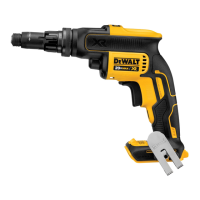10
ENGLISH
Dead Spindle Drive Clutch
This screwdriver is equipped with a dead spindle feature; the
spindle does not turn until the fastener is pressed into the
workpiece. This enables fasteners to be placed onto the drive
accessory of a running screwdriver.
ASSEMBLY AND ADJUSTMENTS
WARNING: To reduce the risk of serious personal
injury, turn tool off and disconnect battery pack
before making any adjustments or removing/
installing attachments or accessories. An accidental
start-up can causeinjury.
WARNING: Use only
battery packs andchargers.
Inserting and Removing the Battery Pack
from the Tool (Fig. D)
NOTE: Make sure your battery pack
11
is fullycharged.
To Install the Battery Pack into the Tool
Handle
1. Align the battery pack
11
with the rails inside the tool’s
handle (Fig. D).
2. Slide it into the handle until the battery pack is firmly seated
in the tool and ensure that you hear the lock snap intoplace.
To Remove the Battery Pack from the Tool
1. Press the release button
10
and firmly pull the battery pack
out of the toolhandle.
2. Insert battery pack into the charger as described in the
charger section of thismanual.
Fuel Gauge Battery Packs (Fig. C)
Some
battery packs include a fuel gauge which
consists of three green LED lights that indicate the level of
charge remaining in the batterypack.
To actuate the fuel gauge, press and hold the fuel gauge button
14
. A combination of the three green LED lights will illuminate
designating the level of charge left. When the level of charge
in the battery is below the usable limit, the fuel gauge will not
illuminate and the battery will need to berecharged.
NOTE: The fuel gauge is only an indication of the charge left on
the battery pack. It does not indicate tool functionality and is
subject to variation based on product components, temperature
and end-userapplication.
Variable Speed Trigger Switch (Fig.A)
To turn the tool “ON”, squeeze the trigger switch
7
. To turn
the tool “OFF” release the trigger. Your tool is equipped with
a variable speed switch which enables you to select the best
speed for a particular application. The farther you squeeze the
trigger, the faster the tool will operate.
Lock-on button
To lock the switch in the ON position for continuous operation,
fully depress the trigger switch
7
and push up the lock-on
button
8
. The tool will continue to run. To turn the tool off,
from a locked-on condition, squeeze and release the trigger
once. Before using the tool (each time), be sure that the locking
button release mechanism is working freely.
CAUTION: Be sure to release the locking mechanism
before removing the battery from the tool. Failure to do so
will cause the tool to start immediately the next time the
battery is installed. Damage or injury could result.
Forward/Reverse Control Lever (Fig.A)
A forward/reverse control lever
6
determines the direction of
the tool and also serves as a lock-off.
To select forward rotation, release the trigger switch
7
and
slide the forward/reverse control lever
(
6
to the left (viewing the
tool from the rear), toward the forward arrow.
To select reverse rotation, release the trigger switch
7
and
slide the forward/reverse control lever
6
to the right (viewing
the tool from the rear), toward the reverse arrow. The centre
position of the control lever locks the trigger switch
7
in the off
position.
When changing the position of the control lever, be sure the
trigger is released.
NOTE: The first time the tool is run after changing the direction
of rotation, you may hear a click on start up. This is normal and
does not indicate a problem.
LED Worklight (Fig.A)
CAUTION: Do not stare into worklight. Serious eye
injury could result.
There is a worklight
9
located on the foot of the tool. The
worklight is activated when the trigger switch is depressed, and
will automatically turn off 20 seconds after the trigger switch is
released. If the trigger switch remains depressed, the worklight
will remain on.
NOTE: The worklight is for lighting the immediate work surface
and is not intended to be used as a flashlight.
Belt Hook (Fig.A)
WARNING: To reduce the risk of serious personal
injury, DO NOT suspend tool overhead or suspend
objects from the belt hook. ONLY hang tool’s belt hook
from a work belt. DO NOT use the belt hook for tethering
or securing the tool to a person or object during use.
WARNING: To reduce the risk of serious personal
injury, ensure the screw holding the belt hook is
secure.
IMPORTANT: When attaching or replacing the belt hook
12
,
use only the screw that is provided. Be sure to securely tighten
the screw.
The belt hook
12
can be be attached to either side of the tool
using only the screw provided, to accommodate left- or right-
handed users. If the hook is not desired at all, it can be removed
from the tool.
To move belt hook, remove the screw that holds it in place then
reassemble on the opposite side. Be sure to securely tighten
thescrew.

